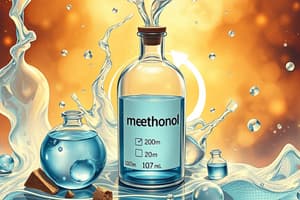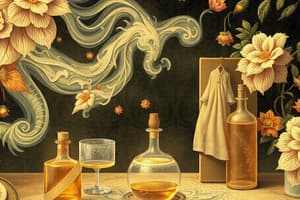Podcast
Questions and Answers
Which alcohol is commonly used as a high-performance fuel?
Which alcohol is commonly used as a high-performance fuel?
- Ethanol
- Butanol
- Propanol
- Methanol (correct)
Alcohols have lower boiling points than the corresponding alkanes with the same number of carbon atoms.
Alcohols have lower boiling points than the corresponding alkanes with the same number of carbon atoms.
False (B)
What is the functional group present in alcohols?
What is the functional group present in alcohols?
hydroxyl group
In naming alcohols, the suffix __________ is added to the stem name of the longest carbon chain.
In naming alcohols, the suffix __________ is added to the stem name of the longest carbon chain.
Match the following alcohols to their primary uses:
Match the following alcohols to their primary uses:
Which of the following statements best describes the volatility of alcohols compared to alkanes?
Which of the following statements best describes the volatility of alcohols compared to alkanes?
Alcohols are more polar than alkanes due to the presence of hydroxyl groups.
Alcohols are more polar than alkanes due to the presence of hydroxyl groups.
What happens to the differences in physical properties between alcohols and alkanes as the carbon chain length increases?
What happens to the differences in physical properties between alcohols and alkanes as the carbon chain length increases?
What is the product when a primary alcohol is heated under reflux with excess acidified potassium dichromate?
What is the product when a primary alcohol is heated under reflux with excess acidified potassium dichromate?
Tertiary alcohols can be oxidised using acidified potassium dichromate.
Tertiary alcohols can be oxidised using acidified potassium dichromate.
What colour change occurs when dichromate (VI) ions are reduced during the oxidation of primary alcohols?
What colour change occurs when dichromate (VI) ions are reduced during the oxidation of primary alcohols?
If a primary alcohol is oxidised to an aldehyde, it must be ____ out to prevent further oxidation.
If a primary alcohol is oxidised to an aldehyde, it must be ____ out to prevent further oxidation.
Match the alcohol types with their corresponding oxidation products:
Match the alcohol types with their corresponding oxidation products:
What must be done to ensure that aldehyde is formed from a primary alcohol?
What must be done to ensure that aldehyde is formed from a primary alcohol?
Oxidation of secondary alcohols can result in the formation of carboxylic acids.
Oxidation of secondary alcohols can result in the formation of carboxylic acids.
What is the oxidising agent used in the oxidation of alcohols?
What is the oxidising agent used in the oxidation of alcohols?
Which type of alcohol is characterized by an -OH group attached to a carbon with two hydrogen atoms and one alkyl group?
Which type of alcohol is characterized by an -OH group attached to a carbon with two hydrogen atoms and one alkyl group?
Ethanol is classified as a secondary alcohol.
Ethanol is classified as a secondary alcohol.
What is produced when alcohols are completely burned in the presence of oxygen?
What is produced when alcohols are completely burned in the presence of oxygen?
The reaction of potassium dichromate (VI) with primary and secondary alcohols is used for ________.
The reaction of potassium dichromate (VI) with primary and secondary alcohols is used for ________.
Match the following types of alcohols with their characteristics:
Match the following types of alcohols with their characteristics:
Which statement is true regarding the solubility of alcohols?
Which statement is true regarding the solubility of alcohols?
Secondary alcohols can be oxidized by potassium dichromate (VI).
Secondary alcohols can be oxidized by potassium dichromate (VI).
What changes occur in the color of potassium dichromate (VI) during the oxidation of alcohols?
What changes occur in the color of potassium dichromate (VI) during the oxidation of alcohols?
Flashcards
Dehydration
Dehydration
A reaction where a water molecule is removed from a molecule.
Solubility
Solubility
The ability of a substance to dissolve in another substance, usually water in this context.
Hydrogen bond
Hydrogen bond
A type of chemical bond where a hydrogen atom is attracted to a highly electronegative atom, like oxygen or nitrogen.
Oxidation of a primary alcohol to an aldehyde
Oxidation of a primary alcohol to an aldehyde
Signup and view all the flashcards
Water-insoluble compound
Water-insoluble compound
Signup and view all the flashcards
Oxidation of a primary alcohol to a carboxylic acid
Oxidation of a primary alcohol to a carboxylic acid
Signup and view all the flashcards
Alcohol
Alcohol
Signup and view all the flashcards
Oxidation of a secondary alcohol
Oxidation of a secondary alcohol
Signup and view all the flashcards
Oxidation of tertiary alcohols
Oxidation of tertiary alcohols
Signup and view all the flashcards
Primary alcohol
Primary alcohol
Signup and view all the flashcards
Secondary alcohol
Secondary alcohol
Signup and view all the flashcards
Dichromate (VI) reduction
Dichromate (VI) reduction
Signup and view all the flashcards
Oxidation of aldehydes
Oxidation of aldehydes
Signup and view all the flashcards
Tertiary alcohol
Tertiary alcohol
Signup and view all the flashcards
Oxidation of ketones
Oxidation of ketones
Signup and view all the flashcards
Combustion of alcohols
Combustion of alcohols
Signup and view all the flashcards
Hydroxyl Group
Hydroxyl Group
Signup and view all the flashcards
Methanol
Methanol
Signup and view all the flashcards
Ethanol
Ethanol
Signup and view all the flashcards
How are alcohols named?
How are alcohols named?
Signup and view all the flashcards
Why are alcohols less volatile?
Why are alcohols less volatile?
Signup and view all the flashcards
Intermolecular Forces
Intermolecular Forces
Signup and view all the flashcards
Study Notes
The Alcohol Homologous Series
- Alcohols contain a hydroxyl (-OH) functional group.
- The hydroxyl group affects both the physical and chemical properties of alcohols.
- Methanol (CH3OH) is the simplest alcohol.
- Methanol is a high-performance fuel due to efficient combustion.
- Methanol is also a crucial chemical feedstock in various industrial processes.
- Methanol can be converted into polymers, paints, solvents, and more.
- Ethanol (C2H5OH) is the second alcohol in the homologous series.
- Ethanol is primarily used in alcoholic beverages and as a fuel.
- Ethanol is also used as a solvent and feedstock.
Naming Alcohols
- The suffix "-ol" is added to the stem name of the longest carbon chain.
- The position of the alcohol functional group in the chain is indicated with a number.
Physical Properties
- Alcohols are less volatile than alkanes with the same number of carbon atoms.
- Alcohols have higher melting points than corresponding alkanes.
- Alcohols exhibit greater water solubility compared to alkanes.
- The differences in properties lessen with increasing carbon chain length.
- Alkanes have nonpolar bonds due to similar electronegativity of hydrogen and carbon.
- Alkanes have weak London dispersion forces.
- Alcohols have a polar O-H bond due to electronegativity difference between oxygen and hydrogen.
- Alcohols are polar molecules with weak London dispersion forces and stronger hydrogen bonds.
- Hydrogen bonds between polar O-H groups in alcohols lead to higher boiling points compared to alkanes.
- Alcohols can form hydrogen bonds with water molecules, causing high water solubility.
Classifying Alcohols
-
Alcohols are categorized as primary, secondary, or tertiary based on the number of alkyl groups attached to the carbon atom bearing the hydroxyl group.
-
Primary alcohols have one alkyl group.
-
Secondary alcohols have two alkyl groups.
-
Tertiary alcohols have three alkyl groups.
-
Methanol and ethanol are primary alcohols.
Combustion of Alcohols
- Alcohols burn completely in excess oxygen to produce carbon dioxide and water.
- The heat released increases with increasing carbon chain length.
- The equation for the complete combustion of ethanol is C2H5OH(l) + 3O2(g) → 2CO2(g) + 3H2O(l)
Oxidation of Alcohols
- Primary alcohols can be oxidized to aldehydes or carboxylic acids, depending on reaction conditions.
- Secondary alcohols are oxidized to ketones.
- Tertiary alcohols do not undergo oxidation.
- Oxidizing agents like potassium dichromate (VI) can be used to determine if an alcohol is oxidized.
- Orange dichromate (VI) reduces to a green chromium (III) solution during the oxidation.
Dehydration of Alcohols
- Dehydration is the reaction that removes a water molecule from the starting alcohol.
- The process is an elimination reaction, creating an alkene as the product.
- Concentrated sulfuric or phosphoric acid are used as catalysts in this process.
Preparation of Haloalkanes
- Alcohols can react with hydrogen halides (like HBr) to produce haloalkanes.
- This reaction usually involves heating the alcohol with a hydrogen halide in the presence of a catalyst like sulfuric acid.
Studying That Suits You
Use AI to generate personalized quizzes and flashcards to suit your learning preferences.




